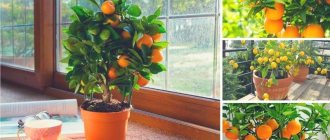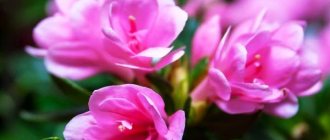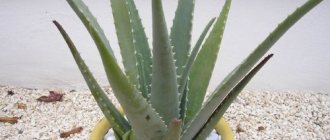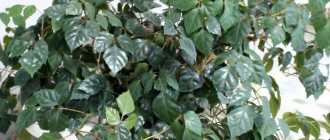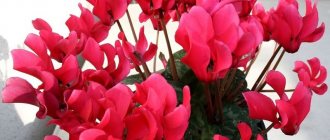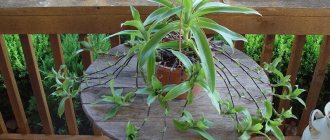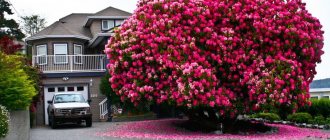Banana palm (tree) is an ornamental plant that will add exoticism to the interior, and with regular care it will begin to bear fruit. The plant requires a lot of light and space. If these conditions are not met, the leaves will begin to lose color and over time the palm tree will die. With appropriate treatment, after 1 - 2 years its height will be more than 2 m. In the 3rd - 5th year of cultivation, it begins to bear fruit. You can grow a palm tree yourself from seeds or a small shoot. It is not recommended to buy a large plant, as it has difficulty adapting to a new environment and may die. The article describes in detail how to grow a banana palm at home.
Lighting and temperature
If you want to get fruits, then you need to arrange additional lighting. The banana palm tree should be illuminated for at least 12 hours during the day, and the air temperature in the house during the day should be maintained at twenty-five degrees or more. At night, conditions may be colder, but the temperature should not drop below 20 degrees Celsius. This is what fruiting is all about.
To grow a banana palm for decorative purposes, room temperature will be enough, and it does not need additional lighting at all. The plant will bloom without it, beautifully and for a long time. But since the banana comes from warm countries, temperatures below 16 degrees C can slow down its growth.
SEED PREPARATION
The protective skin of the banana seed must be broken so that water can seep into the embryo and it will sprout. A knife or needle is suitable for this. If the crust is pierced through, the seed will die. After this, the seeds must be treated with potassium permanganate for 30 minutes and then soaked in warm water for 24 hours.
Watering
Now a little about watering. You need to water it like this: summer watering should be frequent and abundant, and winter watering should be very moderate. Here you need to focus on the degree of drying of the earthen clod. However, this will be noticeable anyway, because in summer the plant will require much more water, it will drink more, and the soil in the pot will dry out much faster. In winter, the plant requires much less water, so the drying of the earthen clod slows down, and therefore, it needs to be watered less often.
Water for irrigation should only be used that has been left to sit for half a day, and its temperature should be several degrees higher than normal room temperature (2-3 degrees will be enough). Under these conditions, your banana palm will be able to grow and develop without any complications.
If you provide your pet with good and constant care, then every week she will delight you with a new beautiful leaf. By the way, thanks to this, the banana tree holds the record for the fastest development among indoor plants.
VARIETIES
The appearance of the plant will depend on the type of tree: height, trunk diameter, leaf size. The height of dwarf varieties is from 1.5 to 4 m. Below are varieties that are well suited as indoor plants.
- Red
- Cavendish
- Brazilian
- Jamaican
- Kyiv dwarf
- Rajapuri
- Williams Hybrid
- Lady fingers
- Gran Nain
Hydration
If the leaves or their edges begin to fade and dry out on a banana tree, this means that the air in the room where it is located is too dry. Therefore, air humidity should be increased immediately. To do this, the banana tree needs to undergo water treatments: wash in the shower, spray, wipe the leaves with a soft and damp cloth. Consequently, regular water treatments will save your plant from drying out and it will have a luxurious green appearance, especially since doing this at home is not at all difficult.
There is another simple way to humidify the air. You need to take a large container (like a pallet), put a pot with a palm tree in it, cover it with pebbles, expanded clay or any other material that absorbs moisture well and retains it (you can use wet moss). Thus, your tree will constantly be in a humid environment, and this is very useful for it.
We talked about how to monitor a purchased young plant. Now let’s talk about how you can grow it yourself (from scratch).
General information
Description of the plant - how do bananas grow?
Most of the varieties of this plant are found in Southeast Asia and Africa. Banana can be grown as an ornamental crop in our regions; in addition, it grows in the Caucasus Republic, but the climate is not suitable for fruit ripening.
Practicing flower growers grow dwarf varieties of the crop at home. In this case, the bushes grow quite lush, they have green and lush foliage. At home, a banana palm can reach 4 m in height, but in the wild, this size sometimes exceeds 13 meters.
Banana is a perennial herbaceous plant and its fruits, which is why it is wrong to say that they grow on trees and palms. The only thing the banana bush has in common with the palm tree is the growing climate. There are approximately 70 species in this genus, including both edible and ornamental varieties.
Interesting! Many who see a banana in the wild may be surprised that this herb or bush can be taller than a classic palm tree.
The thick shoot, which looks like a trunk, is actually a pseudostem, which is formed from many leaf bases. The true stem is located in the ground and is called a rhizome. In fact, it is a spherical rhizome.
Banana palm flowers are usually colored in shades of yellow and red, and are collected in inflorescences at the tops of the shoots. When the fruiting period ends, the upper part of the plant dies off and is replaced by new shoots emerging from the rhizome. New above-ground parts repeat the vegetation cycle again. This happens for 40 years while the stem remains active underground.
Types of banana palms with descriptions
The entire variety of varieties can be divided into 2 groups: fruit and ornamental.
Decorative varieties that are grown for interior landscaping include plants with an inedible fruit part; they reproduce by shoots and shifts.
Among the most popular varieties you can find:
- Lavender banana, about 1.5 meters high. The variety blooms with purple flowers with an orange tint, after which red bananas are formed; they serve only a decorative role and are not eaten.
- Scarlet banana grows no higher than 1 meter. The banana palm leaf is dark green in color and the flowers are bright red. The flowering period lasts up to 2 months.
- Banana Pink Velvet can be up to 1.3 meters in height. Flowering and fruiting begin in the second year of cultivation. The buds have a pleasant smell and pink color. The fruits are also purple.
- The Bloody Banana is so named because of the red spots on the bright green leaves. This makes the plant even more decorative. The fruits are not similar to classic bananas and are not eaten.
Fruit varieties are mainly used for growing tasty fruits. These species can only reproduce vegetatively. Popular varieties include:
- Banana Kiev dwarf whose height is only 1.5-1.7 meters. It is resistant to diseases, frost and pest damage. During one growing season it can produce about 200 sweet and aromatic fruits.
- The Superdwarf banana is slightly lower in height - 1-1.3 meters and has slightly fewer fruits - about 150 pieces per year.
- The Cavendish Superdwarf banana does not exceed 1.2 meters, is very decorative in appearance and has very tasty and sweet fruits. The first fruits appear a little later than other varieties.
The same variety can be cultivated both indoors and outdoors. Moreover, on the street the height of the bush can reach 10 meters. At home, these figures do not exceed 3 meters, depending on the variety.
What are the benefits of banana?
First of all, the calorie content of banana palm fruits is highly valued. In these values, a banana is even more nutritious than regular potatoes.
Banana can be recommended as a dietary food for people with gastrointestinal problems. The fruit is a good source of antioxidants, which helps prevent cancer. Bananas contain a large amount of microelements and vitamins that are vital for humans.
Important! The peel of banana palm fruit contains a lot of phosphorus and potassium, so it is often used to fertilize indoor plants by soaking it in water or drying it into powder.
Making a mini-greenhouse
To plant, you should take a small plastic cup and fill it with drainage. These could be small pebbles, expanded clay, broken dishes or tiles.
On top of the drainage we place a layer of soil mixture 5 cm thick, consisting of ¾ of well-washed river sand and ¼ of peat. There must be a hole in the bottom of the glass so that the water does not stagnate and, as a result, the roots do not rot.
We cover the glass with glass, so there should be some distance between the surface of the soil mixture and the glass so that the sprouts do not rest against the glass.
PREPARATIONS
You will need: seeds or cuttings, soil, container for planting, fertilizers. Don't try to use seeds from a banana you bought at your local store. Only seeds or layering will give the desired result. How quickly the seeds germinate depends on the variety chosen. For some, 2 – 3 weeks are enough, while for others – 2 months. Be patient and the result will not keep you waiting. When the seed reaches a height of 10–12 cm, the plant should be transplanted into a larger pot. To do this, use the transshipment method so as not to injure the root system.
Mold control
If suddenly any signs of mold appear in the greenhouse, then the soil mixture should be spilled with a solution of manganese, and the glass should be thoroughly washed with detergent.
Do not despair, all these precautions should be observed only for a while, until the seeds germinate and the young shoots become stronger. In just a year, small young sprouts will become a large and strong plant with a stem diameter of up to 15 cm, resting on the ceiling and will become your pride, as it was grown at home. The thick stem of the banana palm, consisting of several leaf petioles, is the false trunk of the tree. It is formed by the curling of leaves during plant development.
FRUITING
If you follow all the care recommendations, then over time the plant will begin to bear fruit. This can happen when there are at least 15 - 20 leaves on it. The fruits of the banana tree are berries, not fruits. They are distinguished by a variety of colors: from bright green to red and yellow, as well as by the taste of the fruit: from sweet to sweet and sour.
Transfer
Although the decorative banana is a long-liver, its lifespan is still relatively short. Bananas grow quickly, begin to bear fruit and die just as quickly. But instead of an outdated plant, many shoots may appear that can be planted in other pots.
The banana palm should be transferred to another container or at least replaced with new fertile soil in the fall. This procedure must be carried out every year, since the palm tree pulls all the useful substances from the soil and stops growing and developing. As soon as development slows down, it should be transferred to a larger container. After a year, with proper care, the banana palm will need a 40-liter container.
LANDING
Fill a small container, 8–10 cm wide, with drainage (small pebbles or expanded clay). Approximately fill the middle of the pot with soil, place a banana seed in the middle and cover it with a small amount of soil. Water the soil well and then keep the soil moist. There must be a hole at the bottom of the container to allow excess water to escape so that it does not stagnate and the roots do not rot. Place the pot in a bright place without direct sunlight. It should be well lit for 13 - 14 hours. If there is a lack of natural light, take care of additional lighting for the plant. The pot must not be allowed to overheat, because... high temperatures can “cook” the roots and the plant will die. If mold appears, fill the soil with potassium permanganate.
How to feed bananas at home
The banana plant can be watered and fertilized at the same time by mixing liquid fertilizer with the appropriate amount of water. Following the manufacturer's instructions usually produces the desired results and prevents excess chemicals that can damage the root system.
Fertilizer should be applied when the plant is about to reach maturity. During this time, the growing leaves will need an excess and constant supply of nutrients to result in a fruitful harvest. The simplest sign of a healthy banana plant is the continuous growth of flowers. This unusually means the plant is ready to produce fruit and needs constant nutrition.
During the growing season, I would recommend feeding your banana tree once a week.
Use a fertilizer that is high in potassium, magnesium and nitrogen as this will help stimulate the growth of your plant. You can use either liquid fertilizer or granular fertilizer, which will dissolve into the soil when you water it.
It is best to look for a fertilizer that is specifically for tropical plants. If you can't find it, then use a balanced fertilizer, which is 20-20-20.
During the fall and winter months, reduce the amount of fertilizer to only once a month.
Banana propagation at home
Banana trees are very easy to propagate due to their unique growth habit. The true banana "trunk" is a really large stem made up of old leaves that grow from the rhizome. In nature, each stem grows to maturity, flowers, bears fruit, and then dies. Meanwhile, the underground rhizome continuously sends up new shoots to keep the plant active.
In banana plantations, gardeners typically trim off additional stems as they emerge, so each rhizome will have only three stems at any given time: one immature stem, one flowering stem, and one fruiting stem. This ensures stable growth of bananas. So propagating bananas is a simple matter of digging up and dividing new stems as they appear, making sure they include some rhizomes and roots.
How to grow banana at home
As with any natural cycle, the banana plant will periodically lose its leaves. Cutting them off can lead to fungal infections and should be avoided. The plant's leaves naturally turn yellow, brown, and then become dry, wrinkled, and fall off. This natural process allows the plant to reabsorb nutrients from dying leaves and thrive without interruption.
Banana plants are not susceptible to pest attacks and require very little care to keep the plant healthy and strong. Keeping it clean will prevent any mite colonies from forming. Washing the leaves with warm soap and water will keep the leaves shiny and free of dust.
Indoor banana plants can be moved outdoors during the summer months to expose them to natural sunlight and strengthen the plant during the winter months it will spend indoors. To minimize any disturbance to the tree or root system, moving platforms should be used when moving the container to another location.
Problems during cultivation
If you properly care for a banana, the plant will not get sick and is rarely affected by pests. But let us indicate some signs that not everything is in order with the plant.
- Drying leaves and a brown border indicate overwatering of the plant and rotting of the roots. It is necessary to replant the banana as quickly as possible, while removing the affected part of the rhizome. The sections are sprinkled with activated carbon.
- Drying leaves may also indicate low air humidity or a decrease in temperature. Just change the banana growing conditions: use a humidifier or regular misting.
- Sometimes the plant is affected by spider mites - white dots appear on the leaves, then the leaf dies. Sometimes thin cobwebs can be seen on the leaves. Remove the affected leaves and wipe the rest with soapy water, treat the plant with insecticides. After a week, carry out the treatment.
Articles on the topic
What is a banana plant
Bananas are perennial plants and are considered herbaceous plants. Contrary to popular belief, their trunks are not wooden. Instead, their stem is created from layers of leaves wrapped around each other to form a trunk. Each banana plant grows from a bulb from which a true stem grows. The stem develops through the center of the stem, which subsequently produces fruit.
Each stem supplies a massive flower cluster that turns white. Another stem grows in its place. This process is repeated until the tree bears fruit, usually after one year of cultivating the new plant. To speed up the process, potassium-rich fertilizers are recommended.
The suckers (puppies) that grow at the base of the plant can be removed to propagate new plants. Once the plants have matured and produced fruit, it is important to leave at least one cutting in place as the mother plant may die.

